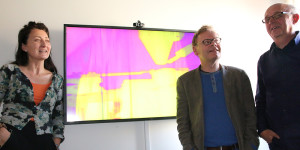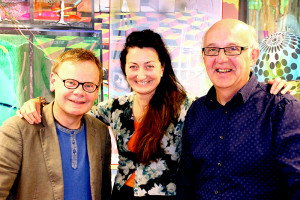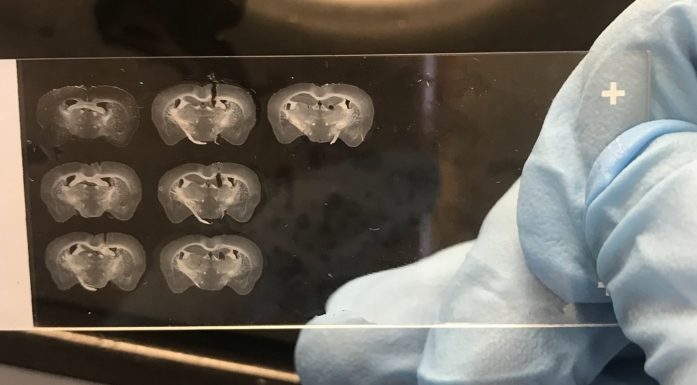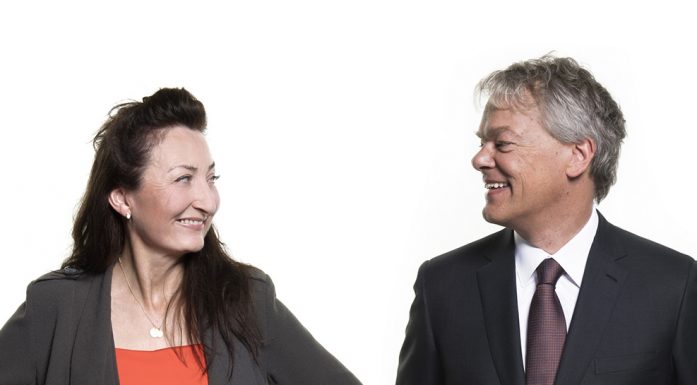Rock-and-roll running rats
Composer Bertil Palmar Johansen calls the rats Gjertrud and Hjørdis “rock-and-roll rats” because they’re so cool. They also star in a new art video about neurological research. The music to the video is built on the sound of brain cell signals from May-Britt Moser’s rats.
NEUROSCIENCE: May-Britt Moser held one of four Presidential Lectures at the Society for Neuroscience conference on brain research in Chicago in late October. What was she looking forward to most about this? Showing the video “My Running Rat”.
The rats that star in the video, Gjertrud and Hjørdis, are used to the limelight. They’ve met journalists, been in photo shoots, and now they are movie stars. They aren’t ‘lab rats’, used for research, because researchers can’t allow their rats to multitask.
Between art and research

May-Britt Moser showed a video made by Johan Magnus Elvemo and Bertil Palmar Johansen to her neuroscience colleagues in Chicago at the end of October. She was extremely excited about the mix of art and science in the video. Photo: Idun Haugan/NTNU
The video with the new music had a pre-premiere showing at the Student Society in Trondheim in early October. Composer Bertil Palmar Johansen, film director Johan Magnus Elvemo and speaker May-Britt Moser were excited to see the video and the audience’s response. And they were all very happy with both.
Most people will see the video as artistic and abstract, with beautiful visual elements, and an exciting soundtrack with a unique background crackle. For neuroscientists, however, the video has many recognizable visible elements, including cell and pattern imagery from the brain. And the crackling? That’s the sound of rat neurons firing.
“I like to describe the video as the result of two artists visiting the lab, like social anthropologists, and describing our research in their own language. And they’ve done so on a spectacular fashion. I find myself watching the video again and again,” says Moser.
- You might also like: A “wow” ending of fog, jazz poetry and a tuba
Started with the Nobel prize
It all started about a year ago.
“We got a call asking if we had any music that we could premiere in conjunction with the Nobel Prize celebrations. So we put our heads together and came up with something,” says composer Bertil Palmar Johansen.
Their new piece, “Chroma” was performed at Dokkhuset in Trondheim during the Nobel Prize ceremony, and during the celebration arranged by the city of Trondheim after May-Britt Moser and Edvard Moser came back from the Nobel Prize awards last December in Stockholm.
“You seemed to like the music, because I was later invited to the brain research centre to make more. I got a tour, and heard a lot of strange sounds that I wanted to work more with,” the composer said to May-Britt Moser.
In addition to the sounds, he was given a video of brain waves and brain activity from the researchers.
Playing is important
“The Kavli institute has a very creative environment. Just sticking your head in the door inspires hundreds of impressions and ideas. We’re like two little boys who’ve been allowed to peek through a keyhole and see all of the exciting things going on inside. Creativity and research go hand in hand— that’s what we’re trying to show,” says Palmar Johansen.

The players: Johan Magnus Elvemo, May-Britt Moser and Bertil Palmar Johansen. Photo: Idun Haugan/NTNU
The artists have been given free rein, and have been playing a lot with their work.
“You can’t just put a bag over a person’s head. Playing is important to us at the brain centre. You have to be able to play to be creative,” Moser points out.
- You might also like: Nobel lectures touch on central discoveries and tantalizing findings
Note system based on brain signals
“The music is based on transcribed signals from rat brains. I’ve slowed the signals down and made a note system of them,” the composer explains.
The brain signal frequency of an alert, moving rat is about 8 Hertz. When it is sleeping, this frequency goes down, but the signals in certain parts of the sleep cycle strongly resemble ones while awake. The sequence of signals from actions like running are repeated.
“These repetitions are the brain sorting out what it experienced while awake,” Moser explains.
Visually beautiful
Johan Magnus Elvemo then visualized the soundtrack, using video clips of film stars Gjertrud and Hjørdis in action, as well as recordings of rat brains in action.
“I’ve worked a lot with colours to create a visual impression that matches the music and rhythm. And there is a lot of beauty to be found in the visual materials from brain research,” Elvemo says. “So I’ve just built on this.”
Advantage in being musical
Fine-tuned listening is an important part of brain research.
“After a research project, it is very important for me to listen to the cells. You put a needle into a hay stack, and out comes music!” says Moser. “The popcorn noises make me happy. I know that if I’ve heard the patter that is made when the animal is walking, and it is a significant, we’ve processed the data correctly. Different cells sound different. This was part of what made discovering grid cells so exciting.”
Hearing these patterns requires an incredibly fine-tuned ear. So it helps a lot to be musical when listening to these ‘popcorn sounds’.
“We train our group to listen to the sounds and analyse the experiments based on what they hear.”
Have to have golden fingers
For these reasons, musicality is a question that comes up if you have a job interview with the Moser-group.
Of course, you have to be good in the field, but after a certain point, scientific excellence just isn’t enough— excellence in all fields is needed, and musicality is certainly a big advantage.
Fine motor skills are also an important quality of anyone working at the Kavli Institute.
“We want people with golden fingers. They have to have what I call a feminine touch,” May-Britt Moser explains.
And last, but not least of the additional requirements to work with May-Britt and Edvard Moser: you have to love animals. That is an absolute must.




